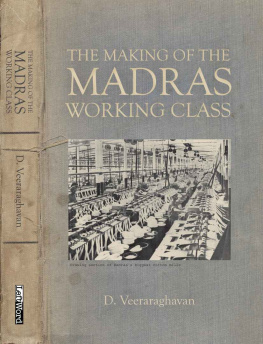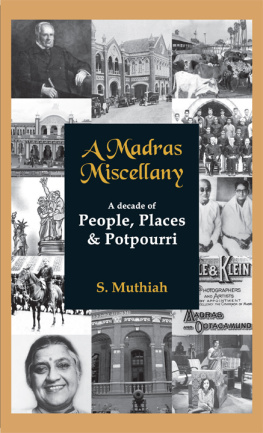Glyn Barlow - The Story of Madras
Here you can read online Glyn Barlow - The Story of Madras full text of the book (entire story) in english for free. Download pdf and epub, get meaning, cover and reviews about this ebook. year: 2015, publisher: Scholars Choice, genre: Romance novel. Description of the work, (preface) as well as reviews are available. Best literature library LitArk.com created for fans of good reading and offers a wide selection of genres:
Romance novel
Science fiction
Adventure
Detective
Science
History
Home and family
Prose
Art
Politics
Computer
Non-fiction
Religion
Business
Children
Humor
Choose a favorite category and find really read worthwhile books. Enjoy immersion in the world of imagination, feel the emotions of the characters or learn something new for yourself, make an fascinating discovery.

- Book:The Story of Madras
- Author:
- Publisher:Scholars Choice
- Genre:
- Year:2015
- Rating:4 / 5
- Favourites:Add to favourites
- Your mark:
- 80
- 1
- 2
- 3
- 4
- 5
The Story of Madras: summary, description and annotation
We offer to read an annotation, description, summary or preface (depends on what the author of the book "The Story of Madras" wrote himself). If you haven't found the necessary information about the book — write in the comments, we will try to find it.
The Story of Madras — read online for free the complete book (whole text) full work
Below is the text of the book, divided by pages. System saving the place of the last page read, allows you to conveniently read the book "The Story of Madras" online for free, without having to search again every time where you left off. Put a bookmark, and you can go to the page where you finished reading at any time.
Font size:
Interval:
Bookmark:

Chepauk Palace.
(Southern half)
BY THE AUTHOR
| PAGE |
| Chap . |
| I. |
| II. |
| III. |
| IV. |
| V. |
| VI. |
| VII. |
| VIII. |
| IX. |
| X. |
| XI. |
| XII. |
| XIII. |
| XIV. |
| XV. |
| PAGE |
| The East India Company established | a.d. 1600 |
| First English settlement, at Masulipatam | 1611 |
| Site of Madras acquired by Mr. Francis Day | 1639 |
| The acquisition confirmed at Chandragiri by the Hindu 'Lord of the Carnatic' | 1639 |
| The Hindu lord of the Carnatic (the Raja of Chandragiri) dethroned by the Mohammedan Sultan of Golconda | 1646 |
| The Company secure from Golconda a fresh title to their possessions | |
| The Sultan of Golconda dethroned by the Moghul Emperor, Aurangzeb, who appoints a 'Nawab of the Carnatic' | 1687 |
| The Company secure from a representative of the Emperor a fresh title to their possessions | |
| Da-ud Khan, Nawab of the Carnatic, invests Madras for three months, and is finally bought off | 1702 |
| In Europe, England and France are engaged in the War of the Austrian Succession | 1740-1748 |
| Dupleix, who is possessed with the idea of making France politically influential in India, is appointed Governor of Pondicherry | 1742 |
| In the war in Europe he sees an opportunity for fighting the English in India, and French forces under LaBourdonnais capture Madras | 1746 |
| Treaty of Aix-la-Chapelle, by which Madras is restored to the English | 1748 |
| Two Carnatic princes quarrel for the Nawabship | 1749 |
| The French and the English in South India join in the quarrel on opposite sides. In the name of the claimant whom the English supported, Clive captures Arcot, the capital of the Carnatic, and then defends the town against the rival claimant and his French supporters | 1749 |
| The French are defeated in the open field, and the struggle is at an end | 1752 |
| In Europe, England and France are engaged in the Seven Years' War | 1756-1763 |
| In India, Count Lally besieges Madras unsuccessfully for more than two months | a.d. 1758-1759 |
| The English defeat the French at Wandiwash | 1760 |
| The English capture Pondicherry | 1761 |
| Treaty of Paris, by which Pondicherry is restored to the French | 1763 |
| (The town was captured again in 1786 and in 1803). | |
| Haidar Ali makes himself Sultan of Mysore about 1760, and reigns till his death, which occurred in | 1781 |
| Tipu, his son, succeeds him, and reigns till he is slain in defending his capital, Seringapatam, against an assault by the English | 1799 |
| (Madras was frequently disturbed by the raids of the father and of the son; and Tipu's death relieved the townsmen of constant anxiety.) | |
| The Supreme Court of Judicature established at Madras | 1801 |
| In default of an heir, the Carnatic 'lapses' to the Company | 1855 |
| The Madras Railway opened for traffic | 1856 |
| The Indian Mutiny | 1857-1859 |
| The Madras University instituted | 1857 |
| The High Court established | 1861 |
Font size:
Interval:
Bookmark:
Similar books «The Story of Madras»
Look at similar books to The Story of Madras. We have selected literature similar in name and meaning in the hope of providing readers with more options to find new, interesting, not yet read works.
Discussion, reviews of the book The Story of Madras and just readers' own opinions. Leave your comments, write what you think about the work, its meaning or the main characters. Specify what exactly you liked and what you didn't like, and why you think so.










